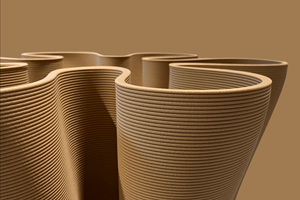Controlled polymer ablation technology seeks to redefine surface prep
CAMX 2024: Plasma Bound’s CPA technology, powered by quality control system Vulcan, applies atmospheric pressure plasma to achieve high-level composite bonding.
Share
Figure 1: Controlled polymer ablation (CPA) process in application. It can be single or multiple heads. Source (All Images) | Plasma Bound
Plasma Bound (Dublin, Ireland), an Irish deep-tech company, excels in high-performance surface preparation for the bonding of composite assemblies across various industries. Its novel solution, controlled polymer ablation (CPA), tackles bonding difficulties for lightweight materials, such as carbon- and glass fiber-reinforced polymers. By using an atmospheric pressure plasma, CPA removes surface polymer, resulting in a highly energized surface with an enhanced surface area ready for bonding or coating.
Figure 2. Plasma Bound’s Vulcan control module, currently used to deploy the CPA process at the line.
The company’s CPA technology is underpinned by commercial atmospheric plasma equipment and is currently deployed using Plasma Bound’s quality assurance and control product, Vulcan (Fig. 2). Vulcan enables in-situ quality validation and process-level control of surfaces for adhesion applications, providing quality assurance records of process and parts on a batch and/or part basis.
Figure 3. Three “milestone” levels of CPA treatment on lightweight composites as viewed by the human eye. Inserts are scanning electron micrographs of the surface.
One of CPA’s stand-out features, is its precise control over the depth of polymer removal from the surface. Fig. 3 illustrates three progressive stages of removal from a carbon fiber composite — untreated, skimmed, partially and fully revealed fibers. The ability to target anywhere along the spectrum of these gradients enables different bonding strategies for different end-uses.
According to Plasma Bound, its CPA technology, powered by Vulcan, has been validated in the automotive sector and offers multiple benefits in various sectors, including:
- Automation: Facilitates faster assembly times and improved bond strengths.
- Lightweighting: Enables automakers to reduce vehicle weight without compromising safety, meeting stringent emissions regulations.
- Sustainability: Minimizes material waste, scrap production and energy consumption, aligning with circular economy principles.
- Fuel efficiency: Enhances fuel efficiency, critical for airlines and space exploration, by expanding the availability of lightweight structures.
- Reduced waste: Replaces wasteful peel-ply and abrasion processes, cutting down on scrap and rework efforts.
- Energy efficiency: Reduces energy consumption through a low-energy input process, eliminating unnecessary process steps, and removing consumables.
- Safer materials: Offers reliability and stronger lightweight structure along with reduced non-compliances.
Plasma Bound’s ambition is to deploy its CPA platform technology globally, to enable manufacturers to improve quality and safety, increase efficiency and reduce cost.
Related Content
-
Bladder-assisted compression molding derivative produces complex, autoclave-quality automotive parts
HP Composites’ AirPower technology enables high-rate CFRP roof production with 50% energy savings for the Maserati MC20.
-
Plant tour: Spirit AeroSystems, Belfast, Northern Ireland, U.K.
Purpose-built facility employs resin transfer infusion (RTI) and assembly technology to manufacture today’s composite A220 wings, and prepares for future new programs and production ramp-ups.
-
Active core molding: A new way to make composite parts
Koridion expandable material is combined with induction-heated molds to make high-quality, complex-shaped parts in minutes with 40% less material and 90% less energy, unlocking new possibilities in design and production.
Related Content
Bladder-assisted compression molding derivative produces complex, autoclave-quality automotive parts
HP Composites’ AirPower technology enables high-rate CFRP roof production with 50% energy savings for the Maserati MC20.
Read MorePlant tour: Spirit AeroSystems, Belfast, Northern Ireland, U.K.
Purpose-built facility employs resin transfer infusion (RTI) and assembly technology to manufacture today’s composite A220 wings, and prepares for future new programs and production ramp-ups.
Read MoreActive core molding: A new way to make composite parts
Koridion expandable material is combined with induction-heated molds to make high-quality, complex-shaped parts in minutes with 40% less material and 90% less energy, unlocking new possibilities in design and production.
Read MoreSulapac introduces Sulapac Flow 1.7 to replace PLA, ABS and PP in FDM, FGF
Available as filament and granules for extrusion, new wood composite matches properties yet is compostable, eliminates microplastics and reduces carbon footprint.
Read MoreRead Next
Plasma treatment as surface preparation for adhesive bonding
Concurrent with the TRUST program's development of process control, it is addressing the need for more robust surface prep. methods.
Read MoreWelding is not bonding
Discussion of the issues in our understanding of thermoplastic composite welded structures and certification of the latest materials and welding technologies for future airframes.
Read MoreAll-recycled, needle-punched nonwoven CFRP slashes carbon footprint of Formula 2 seat
Dallara and Tenowo collaborate to produce a race-ready Formula 2 seat using recycled carbon fiber, reducing CO2 emissions by 97.5% compared to virgin materials.
Read More












